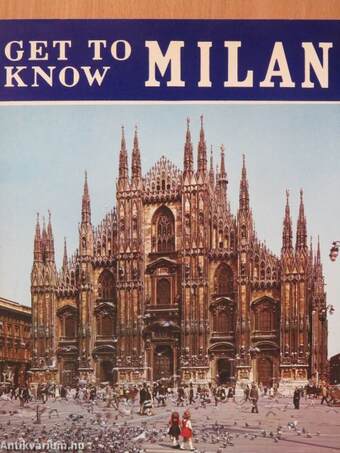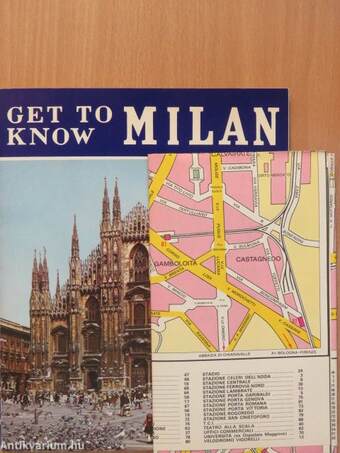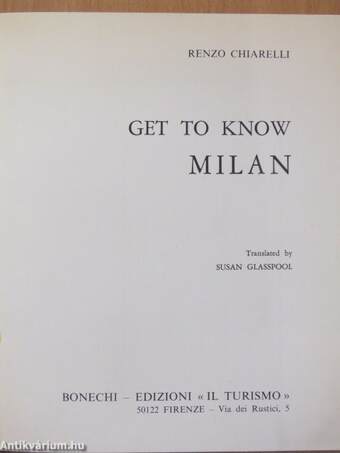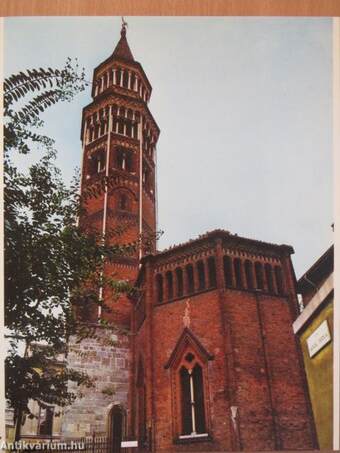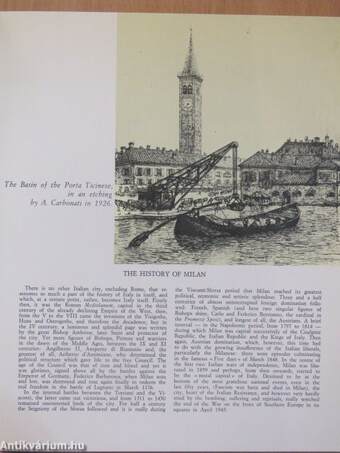1.066.456
kiadvánnyal nyújtjuk Magyarország legnagyobb antikvár könyv-kínálatát

VISSZA
A TETEJÉRE
JAVASLATOKÉszre-
vételek
Get to Know Milan
| Kiadó: | Bonechi - Edizioni «Il Turismo» |
|---|---|
| Kiadás helye: | Firenze |
| Kiadás éve: | |
| Kötés típusa: | Varrott papírkötés |
| Oldalszám: | 62 oldal |
| Sorozatcím: | |
| Kötetszám: | |
| Nyelv: | Angol |
| Méret: | 24 cm x 19 cm |
| ISBN: | |
| Megjegyzés: | Színes fotókkal. Térképmelléklettel. |
naponta értesítjük a beérkező friss
kiadványokról
naponta értesítjük a beérkező friss
kiadványokról
Előszó
GET TO KNOW MILAN Can one know a city like Milan deeply? Perhaps yes, perhaps no, it depends: one can try, however, to understand it, as we attempt to do in a few pages, looking it its exterior... TovábbElőszó
GET TO KNOW MILAN Can one know a city like Milan deeply? Perhaps yes, perhaps no, it depends: one can try, however, to understand it, as we attempt to do in a few pages, looking it its exterior forms above all, but also trying to penetrate its « inside », across and over the curtain walls. It is clear that we are not proposing to make an analysis here, neither thorough, nor complete - as very .many others have already made, and splendidly - of Milan, its culture, costume, life and productive capacity: we attempt much more simply to give a succinct representation in an equally short visual synthesis, conducted through «appointed places» across a selected sequence of flashes. However, Milan, to begin with, is a city that one must study carefully, even from the outside. A city of difficult topography, where the antique reticle of the Romans has been cancelled and overwhelmed by the intricate disorder of the mediaeval streets and by all that has come after: disembowelments, vertical, horizontal, diagonal and radial cuts, especially in the whole of the last century, so that the city is ramified and spread out as God and many development plans, (from the one in 1865 to the prosopopeiae ones of the Lictorian age), have willed. The canals covered over, the Spanish bastions cast down, for a long time already it has been lost in the most part, - and even if that is not everything - that which in the epoch of Stendhal figured among the most beautiful cities in Europe. Perhaps no other Italian city is openly revealed like Milan over the urbanistic stratifications, in its metamorphasis and continued growth. The passage from old to not so old, to the new, comes in fact here in the middle of operations « in sight », like pieces of mosaic which fit into place one after another; in this way it shifts from antique to modern, from liberty to the pretentious « twentieth century », to functional and futuristic architecture of today: all of it, maybe, assembled in the same way. In this, Milan is a city full of contradictions: the skyscrapers and, in a step, the old and blackened houses which the contrast makes humbler and more dismaying. It happens therefore, that the palaces of a, however, declared architectural value (and there are many), often appear placed in an unrelated setting and in an indifferent connective: and even more so are the city gates, (some are very beautiful, like the Postern of St. Ambrose or the turreted Porta Ticinese or the Porta Nuova, which one cannot look at without Barbarossa coming to mind every time), cut off from their natural context by the destroyed walls, and not less than others later, they figure like the mythical testimony of worlds replaced one after the other, but lost just the same. It is said that, luckily, all of monumental Milan (meaning also the «minor» things), and romantic Milan, dear to Stendhal and to Porta, to Grossi, and even now, to De Marchi, consacrated in the views of Inganni and Migliara, is definately not lost. That Milan still remains in the ambiguous and contorted movement of the many old streets, in the aristocratic and detached severity of others wich are more solemn: one for example, is Via Brera, or there are other very beautiful ones between Via Manzoni and Montenapoleone, (this latter is the most « Parisian » of the Milanese roads, because of its singular assonance of form, volume and quality), and of the «hawsers » of the peripheric Canals. This «-secret soul » of the old Milan remains in the rare surviving stone covered pavements, in the houses « with the galleries with the stench of cats, and with the flowering vases of March » which Buzzi recounts, in the underneath part of the porticoes which lead to the interior of the low courtyards by long terraces with the bannisters of iron or wood, in the funeral drapes which decorate a doorway if a misfortune has occured inside, in the pathetic note of the colour which springs out sometimes from the pink slabs of the many paviments and even pinker if it rains. « It is necessary to wind up - wrote Piovene in his by now classic « Voyage in Italy » - the com- VisszaTémakörök
- Idegennyelv > Idegennyelvű könyvek > Angol > Művészetek > Fotóművészet
- Idegennyelv > Idegennyelvű könyvek > Angol > Útikönyvek
- Útikönyvek > Európa > Dél-Európa > Városai
- Útikönyvek > Idegennyelvű útikönyvek > Angol
- Útikönyvek > Utazás, turizmus
- Útikönyvek > Természetjárás, túrák > Városnézés
- Művészetek > Fotóművészet > Albumok > Külföldi
- Művészetek > Fotóművészet > Albumok > Tematikus
- Művészetek > Fotóművészet > Idegen nyelv > Angol
- Művészetek > Fotóművészet > Témái > Városok > Külföldi
Renzo Chiarelli
Renzo Chiarelli műveinek az Antikvarium.hu-n kapható vagy előjegyezhető listáját itt tekintheti meg: Renzo Chiarelli könyvek, művekMegvásárolható példányok
Nincs megvásárolható példány
A könyv összes megrendelhető példánya elfogyott. Ha kívánja, előjegyezheti a könyvet, és amint a könyv egy újabb példánya elérhető lesz, értesítjük.



